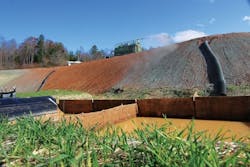About the author: Jim Wahl is owner and president of Wahl Communications. Wahl can be reached at [email protected] or 513.561.2002.
The Appalachian elktoe mussel is small—about 4 in. wide—and critically endangered. Populations of the mollusk are hard to find and study, but they prefer the cool, fast-flowing streams of western North Carolina and eastern Tennessee. They prefer one river in particular: the South Toe River, just north of the Pisgah National Forest.
The North Carolina Department of Transportation (NCDOT) also has taken an interest in that stretch of the river, as it begins an 8-mile-long, $71 million state-funded project to expand two-lane U.S. Route 19 to four lanes between Burnsville and Spruce Pine, N.C. The estimated completion of the project is 2019.
Regulations & Planning
High Country Hydroseeding was contracted to perform and supervise erosion control for the project, following Wright Brothers Construction Co. Inc., the contractor in charge of clearing land and grading slopes. Leading High Country in this effort is Project Manager Allen Stewart. Stewart oversees his crews, managing all 250 acres of the project, first installing silt fences on the slopes, then baffles and skimmers in the basins, and finally permanently seeding and matting the slopes.
Given the $71 million bill, the nearby Pisgah National Forest and the even closer endangered mussel habitat, the Route 19 project had a number of regulations in place.
NCDOT has a number of regulatory procedures to protect watersheds, including approving the specific type of temporary and permanent seed used. Stewart used a Bowie hydromulcher to apply Conwed Fibers 2000 pure wood mulch, as well as double-net straw matting, which Stewart said is used on almost all NCDOT jobs.
Given the sensitive nature of the watershed, NCDOT has indicated that only 20 acres of land can be exposed at a time to prevent unnecessary soil erosion and pollution of the mussels' habitat. If more than 20 acres are disturbed and not yet permanently seeded, Stewart is directed to stabilize through temporary seeding and mulching. Additionally, all NCDOT projects require 2 tons of limestone per acre to correct the pH in the soil.
Stewart was able to juggle all of these requirements—the quick coverage timeline, the specific seed types and the limestone—with an Imperial 3000 hydromulcher. In one application, his crews can spray up to 2 tons of limestone, 500 lb of fertilizer, 150 lb of grass seed mix and 400 lb of mulch. The mulch is used as a tracer, to see what has been covered and what has not. Mulch also lubricates the pump, keeping it maintenance free. One tank load can cover 1 acre of exposed soil.
Such a viscous solution normally causes a serious issue called cavitation—air pockets in the suction line of the hydromulcher. Thicker slurries are problematic for some equipment because the agitators, which keep the ingredients in a suspension, create air pockets. As more turns and bends are introduced in the pathway of the solution, air entrainment is exacerbated. When those air pockets travel through the suction line and into the pump, they create irregular flow patterns, erratic spraying, and, in severe conditions, can lock up and completely stop the pump.
Under heavy scrutiny and behind schedule, it was important for Stewart to use the regulated materials as well as keep work moving. The hydromulcher was designed to eliminate bends in the pump intake and discharge areas, reducing the possibility of cavitation. The project is now moving forward. Stewart estimates that it takes 45 minutes to load the 3,000-gal tank, and 30 minutes to spray an acre.
Protecting the Mussels
On top of the NCDOT regulations to protect the endangered mussels, several organizations are watching the progress of the project closely. Elktoe mussels can be seriously harmed if they are moved or if the chemical balance of their environment changes significantly.
The North Carolina Fish and Wildlife Commission and North Carolina Div. of Water Quality show up unannounced to check the water levels, whether there is any silt in the basins and whether the skimmers are working properly. Members of the Fish and Wildlife Commission regularly wade into the river and check on the mussels.
“This particular project is being monitored much more closely than anything we’ve done before,” Stewart said. “There are more people showing up more often.”
As for Stewart and his crew, the only thing to do is closely follow the regulations and maintain their erosion control systems.
Coping With Rain
Unfortunately for the Route 19 project, the fall of 2015 was a rainy one. After each rain, Stewart and his crew would clean out silt from behind check dams, clean out the basins and apply straw to restabilize the soil. Then, Hurricane Joaquin brought 11 in. of rain in one week, shutting down the project entirely.
Compaction must be between 95% and 100%, and even with 1⁄2 in. of rain, the soil may take five days to dry out enough to get the necessary compaction. All of Stewart’s soil erosion structures are designed on 10- and 15-year rain events, but getting 3 in. in 24 hours is considered a 30-year rain event.
“We’ve been plagued in western North Carolina with rains that our erosion control measures are just not designed to take,” he said.
Only six months into a four-year project, neither Stewart nor the general contractor is as far as they would like to be. The rain has been their worst enemy. After 11 in. of rain, Stewart explained, the only thing to do was clean it up and make repairs as quickly as possible.
Despite the setbacks, Stewart feels confident about the project's progress. He attributes a large part of its success to the hydromulcher, which allowed crews to quickly cover a large swath of exposed soil with everything that needed to be on it: limestone, fertilizer, seed and mulch. The large tank capacity, combined with the powerful mixing capabilities, allowed workers to cover exposed soil quickly and let the seed start taking root—before it started to rain again.
Moving Forward
As fall gave way to winter, the ground dried up enough for the project to pick up again. Regulatory agencies continued their irregular inspections, the contractor continued clearing land and Stewart’s crews continued covering up the exposed soil. Despite the rain, land erosion was kept to a minimum thanks to diligent maintenance, and appropriate equipment.
Those practices ensured that the NCDOT rules were followed, and the agencies maintaining those regulations were satisfied. In turn, those regulations ensure that cars and mussels alike can share in the beauty of the pines and cold rushing waters of western North Carolina.
Click here to watch a video on the project.
Download: Here


